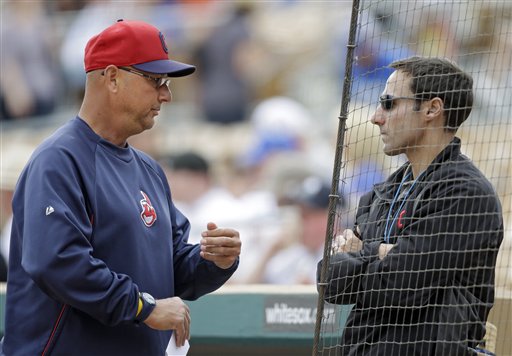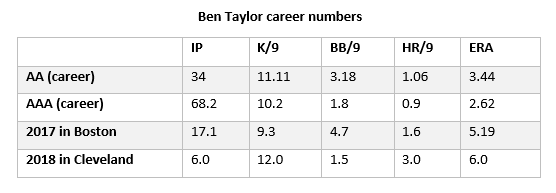As August wraps up, the Cleveland Indians have a comfortable lead in the AL Central. Barring a collapse of historical proportions, Tribe fans won’t need to be glued to their TV sets to see if Cleveland can secure a spot in the 2018 postseason. However, Indians fans may want to tune in for another reason: September call-ups.
For the majority of the season, only 25 players are allowed on any team’s active roster. On Sep. 1, that limit expands to 40 players. As such, teams often use September to give their near-ready prospects a look in the MLB, or otherwise, promote depth options from AAA so they can give the veterans some extra rest.
With Cleveland being playoff bound, September call-ups are even more intriguing, since some players could be auditioning for a potential spot on Cleveland’s 25-man postseason roster.
With that in mind, let’s dive into which new faces could appear in Cleveland next month:
Ben Taylor, RHP:
A waiver claim picked up earlier this season from Boston, Taylor is a virtual lock to be promoted once rosters expand. Taylor already pitched for Cleveland this season, when the club’s bullpen was in complete disarray. The 25-year-old’s numbers in his six inning stint with Cleveland mirrored what he’s done throughout his career.
More than anything, Taylor’s peripherals have always been intriguing. He’s consistently generated a high number of strikeouts (even in the major leagues), and generally has posted solid-to-excellent walk numbers. However, Taylor’s five home runs allowed in just 23.1 innings with Cleveland and Boston are a significant red that he’s too susceptible to the long ball against Major League hitters (especially given his pedestrian home run rates in the high minors).
It might be tempting to attribute Taylor’s sky-high home run rates to bad luck, but when you dive into his scouting reports, misfortune seems less likely. In 2017, FanGraphs’ Eric Longenhagen had this to say about Taylor:
Taylor regularly misses bats with his low- to mid-90s fastball up above the strike zone. It’s a comfortably plus fastball and Taylor fills the zone with it. He also has a fringey slider with inconsistent shape and bite, but it flashes average and could get there with reps and big-league coaching.
There’s some question about how effective Taylor can be as, essentially, a one-pitch guy in the big leagues.
Boston pitching coach Brian Bannister also told FanGraphs’ David Laurila that rather than relying on high-velocity and spin rate to succeed with his fastball, Taylor uses a “big extension that you see translate into a deceptive fastball. He’s not tall-and-fall; it’s more of an old-school drop-and-drive Tom Seaver kind of delivery. It gives hitters a different look, and that’s why his fastball plays up a little bit.”
The fact that Taylor relies heavily on a 92-94 mph fastball (he’s thrown the pitch 67% percent of the time in his 23.1 MLB innings according to Pitch Info) could very easily explain his home run issues.
All that said, if Taylor can work to limit his home runs, he could be a useful addition to Cleveland’s bullpen, which desperately needs quality right-handed options.
ERic Haase, C
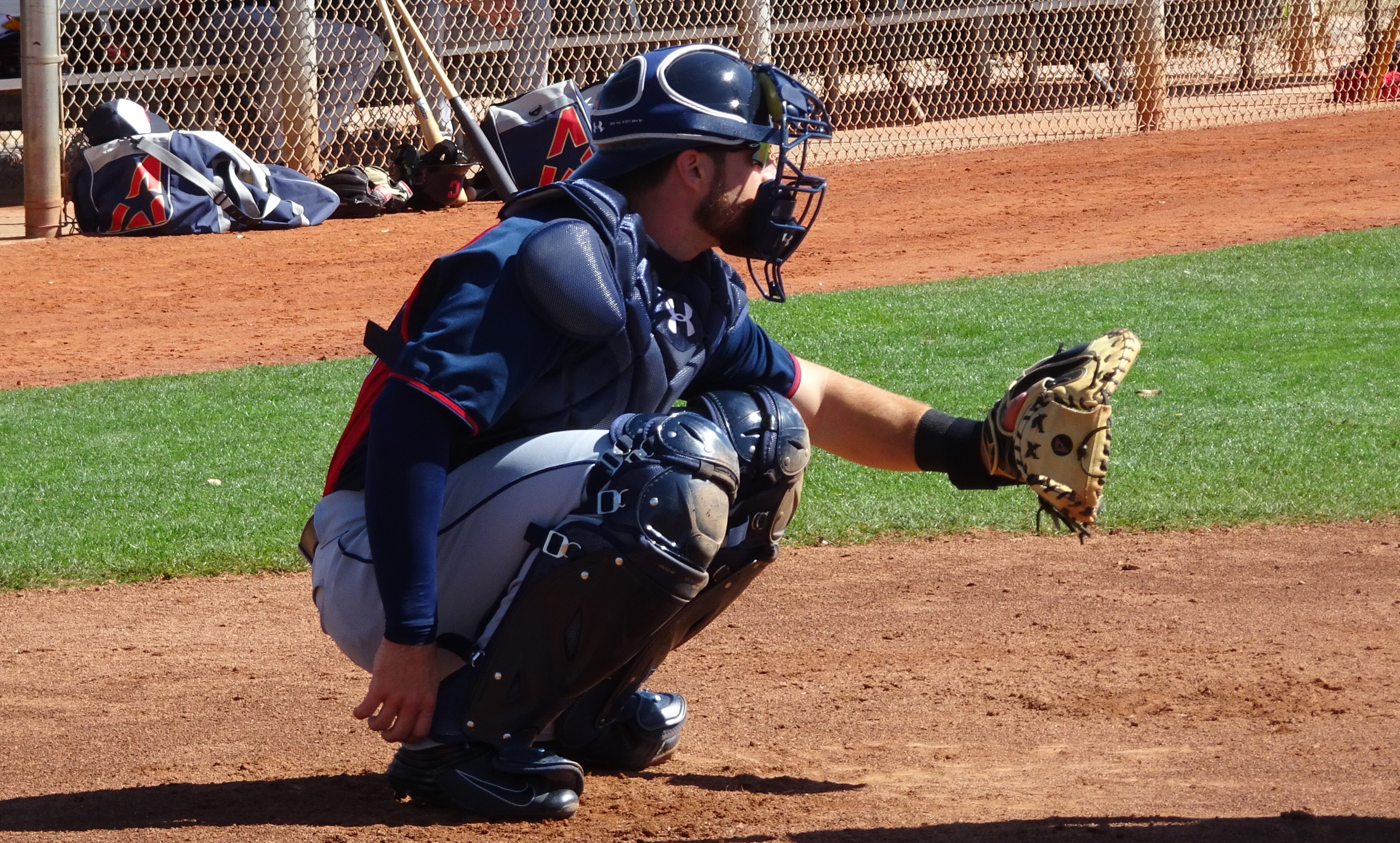
One of the reasons that Cleveland felt comfortable trading away Francisco Mejia, Eric Haase is a high-floor, low-ceiling catcher that is likely to make his MLB debut for Cleveland next month.
After a breakout 2017 season in Akron, Haase’s bat has cooled down this season in Columbus. His overall numbers (.234/.285/.443) largely are brought down by an abysmal start to the season: in his first 47 games of 2018, he only could manage a woeful .211/.268/.337 line, compared to a .250/.295/.516 line since.
Haase’s walk rate this season (6.0%) is way down from 2018 (12.5%), and that has been his biggest issue. That said, his prolific power has still been on display, especially since June, where he has 18 doubles and 16 home runs in 70 games. His power helps to offset his strikeout rate, which has hovered around 30% for the 4th straight season.
At the very least, Haase’s offensive profile should feature a decent walk rate, along with plus power. Meanwhile, scouts are impressed with Haase’s receiving, a sentiment that Andrew Miller echoed earlier this season:
I pitched one game in Akron and one in Lake County, but I was comfortable in Columbus. I think I threw to Haase maybe four times, and he’s really good. That was kind of a treat for me. That helped me kind of settle in the last few innings and really accomplish what I was looking to accomplish, which was just pitching well.
His arm isn’t a 70-grade rocket like Mejia’s, but it’s solid, and much like Yan Gomes, Haase utilizes a quick release which has seen him catch an impressive 45% of would-be base stealers the past two seasons.
At 25, Haase is MLB-ready, and a call-up in September could set the table for him to take on a more permanent role in Cleveland in the coming years.
Yu Chang, SS
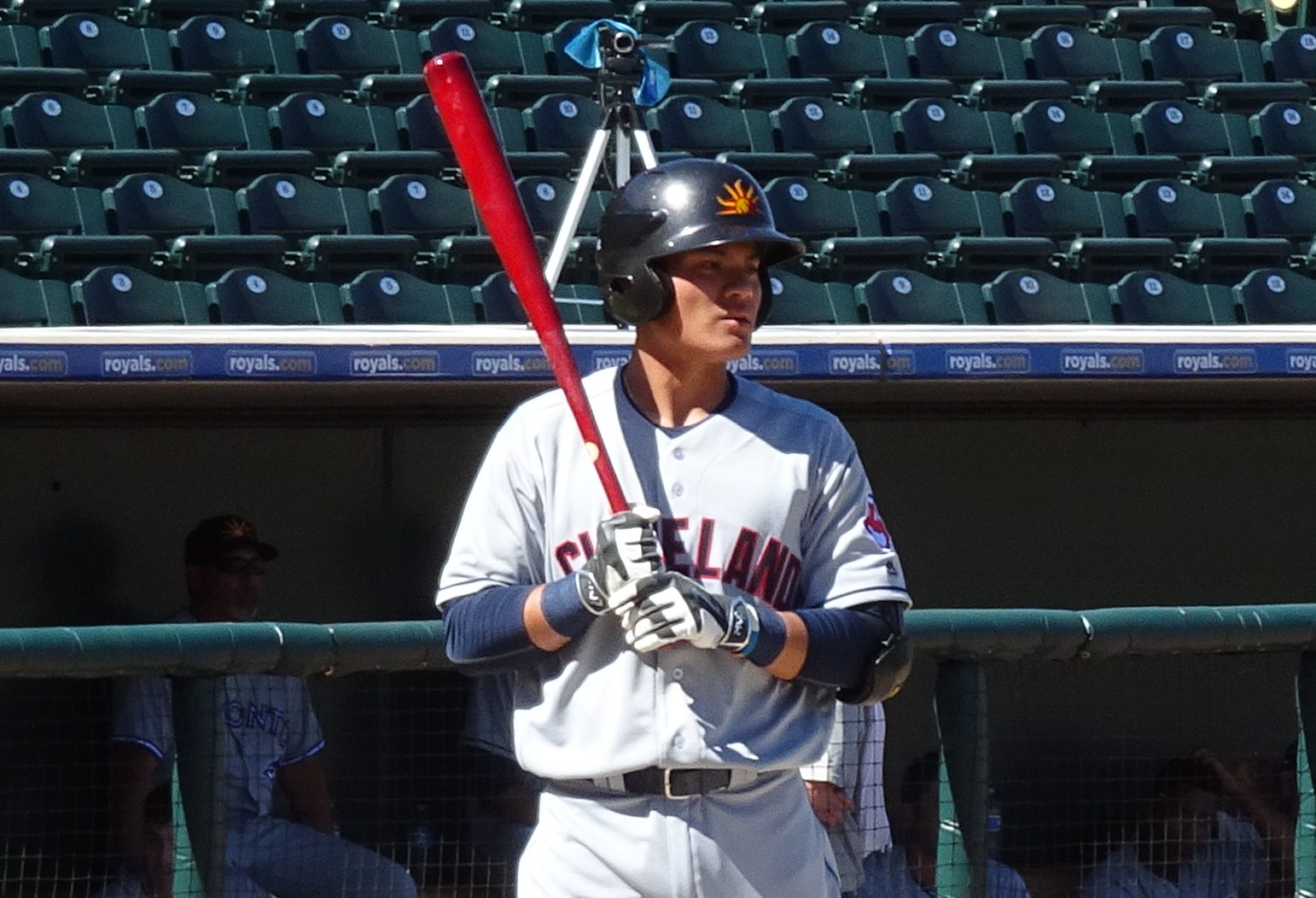
Chang gets little fanfare, despite consistently being ranked among Cleveland’s top five prospects. A shortstop from Taiwan, Chang has solid tools across the board that make scouts believe he can be a useful, if unspectacular MLB-player.
Chang just turned 23, and is enjoying modest success this season with AAA Columbus, posting an overall .252/.325/.399 slash line. Chang’s strikeout numbers have grown as he’s progressed through the minors, but a solid ability to take walks and above-average power numbers help offset the swing-and-miss in his game.
While Chang is considered a competent defender at SS, his future in Cleveland is most certainly not replacing Francisco Lindor. However, it’s certainly possible that Chang could eventually replace Jason Kipnis at second base, so long as he can remain an above-average hitter upon reaching the majors. Beyond that, he also could replace Erik Gonzalez as the team’s utility player, where he would certainly provide an offensive upgrade.
There isn’t much room for Chang on the current roster (especially with Yandy Diaz‘s presence), but it would be a good idea for Cleveland to give Chang a taste of the MLB at some point in September.
Oscar Mercado, CF
A month ago, Oscar Mercado was part of the St. Louis Cardinals’ organization, and his stock had been on the rise over the past couple seasons. Due to a roster crunch, the Cardinals were willing to trade Mercado for a younger, well-regarded OF prospect in Conner Capel, along with an Arizona League lottery ticket in Jhon Torres.
Mercado was drafted as a shortstop, but had trouble adjusting to the position as a professional. However, his plus athleticism allowed him to try playing center field, and by all accounts, he had no trouble with the defensive switch.
Mercado’s ability to play a quality center field was important, but what got scouts excited was that happened to Mercado’s offense after the switch:
After the move, Mercado became a slightly above-average hitter. While his strikeouts ticked up (to be expected at the higher levels of the minor leagues), he also increased his walk rate and began hitting for much more power.
To go along with his recently improved hitting, Mercado has always used his plus speed to add value on the bases: he’s stolen at least 30 bases in each of the past 4 seasons, although with a slightly inefficient success rate of 69%.
Cleveland traded for Mercado because they needed outfield options, and at his best, Mercado projects as a solid hitter, a plus defender, and a plus baserunner. While that wouldn’t make him a superstar, it would make him better than most of the outfielders Cleveland has deployed in recent seasons. His profile was good enough for FanGraphs to rank Mercado as the 6th-best prospect traded at the deadline, and they also currently rank him as the 4th-best prospect in Cleveland’s system.
It will be interesting to see if Mercado gets an opportunity in September. After an offensive outburst in Boston, Greg Allen has posted a -18 wRC+ in the past week. However, he’s still been good for a tolerable 85 wRC+ since he was an originally recalled on Aug. 9. Meanwhile, Mercado initially struggled after the trade, but he’s been on a tear recently (160 wRC+, 7 BB, 6 K in last 13 games).
If Allen continues to struggle, it may be worth giving Mercado a shot in September.
Nick Sandlin, RHP
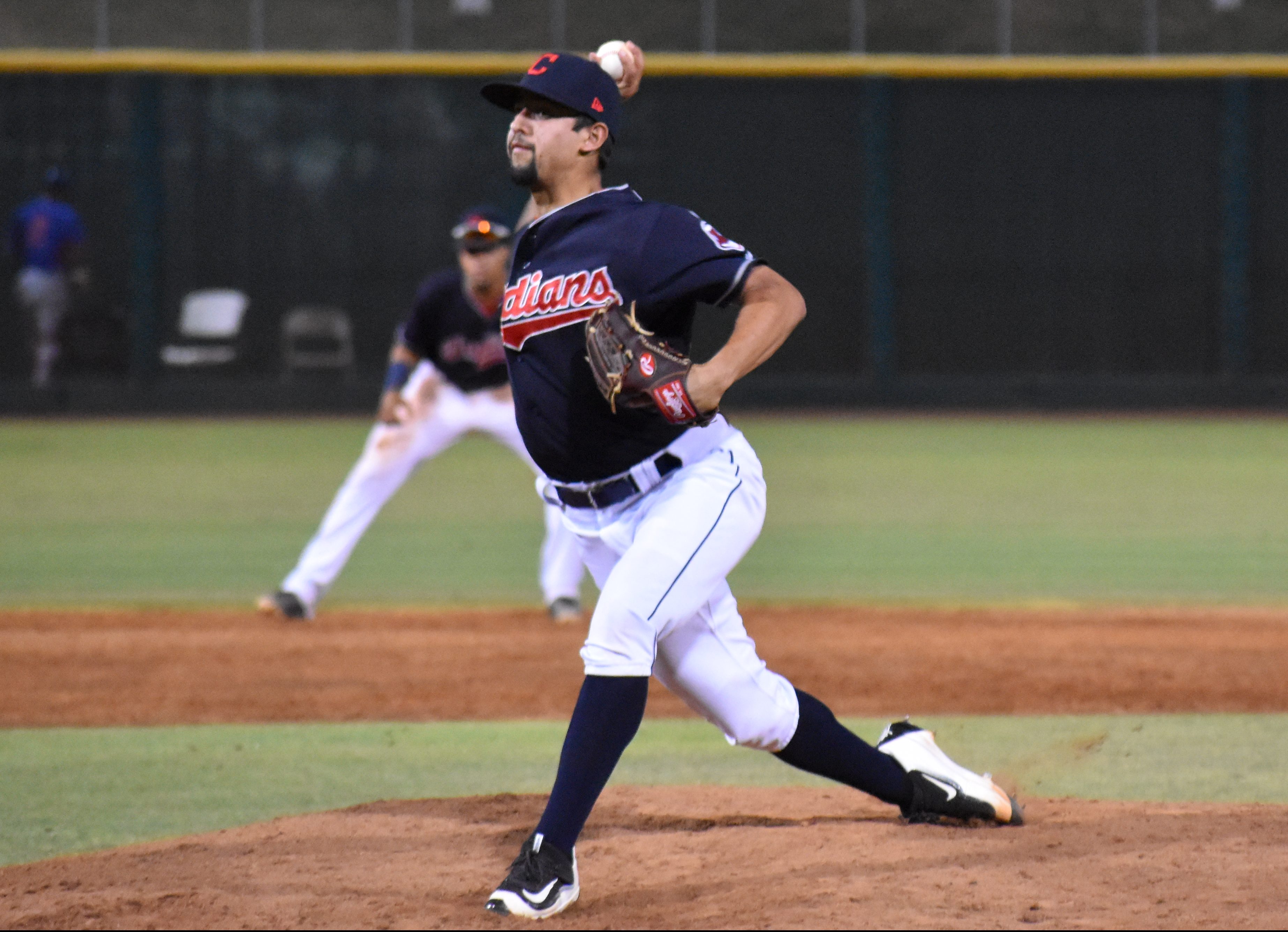
It isn’t every day that you talk about a player getting promoted to the major leagues in the same year they were drafted, but Nick Sandlin isn’t a typical player.
Cleveland drafted Sandlin in the 4th round of the 2018 draft out of Southern Miss. All he did in his junior year was post a 1.06 ERA, to go with 144 strikeouts and just 18 walks in 102.1 innings.
While Sandlin was a starter in his junior year in college, Cleveland liked his sidearm delivery (and absurd numbers) and decided he’d be an excellent candidate to develop as a relief pitcher. Immediately, scouts began predicting Sandlin could be the first player from the 2018 draft class to reach the MLB.
Eric @longenhagen & I said Southern Miss sidearm RHP Nick Sandlin would reach MLB first from the 2018 draft. Cleveland popped him 67th overall for a below slot bonus & he's in High-A w/this line, all in relief, over 3 levels: 16.2 IP, 13 H, 3 R, 0 BB, 25 K https://t.co/DpfjvoVv1J
— Kiley McDaniel (@kileymcd) August 14, 2018
As the tweet notes, Sandlin has continued posting absurd numbers as a professional. Now in AA, Sandlin has pitched 22.1 innings across 4 levels, and has recorded 33 strikeouts and 2 walks, with just 18 hits and 5 runs allowed. His stuff isn’t spectacular – he sits 91-94 with average secondary pitches – but he relies on deception and varying arm slots to keep hitters off balance. To date, it has worked.
At the very least, Sandlin will need a few more outings in AA before the Indians decide whether they’ll promote him to the MLB, but considering they need right-handed help in the bullpen, they club may be forced to see what Sandlin can provide.
Evan Marshall, RHP:
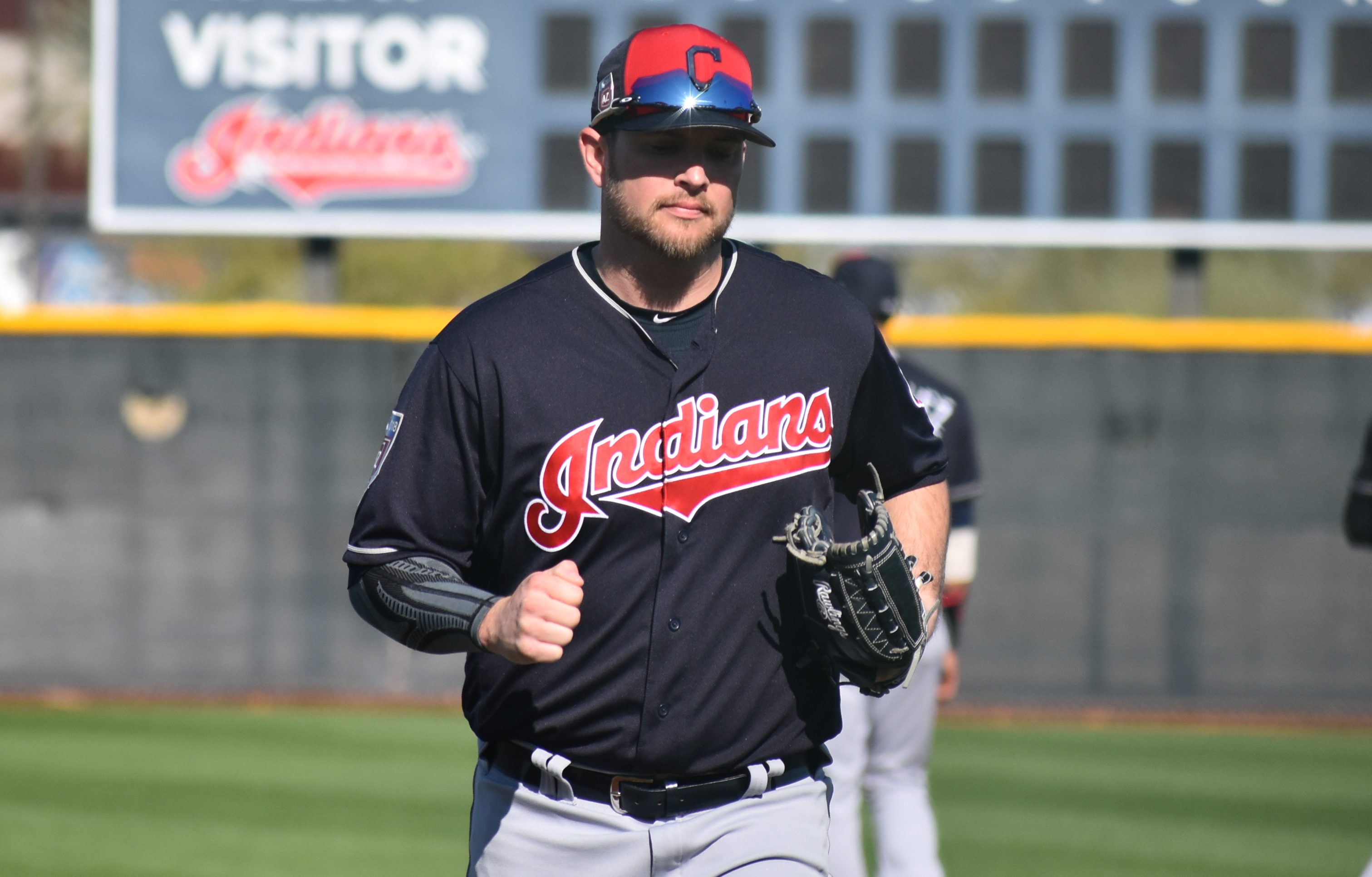
Evan Marshall was one of the feel-good stories of Cleveland’s spring training, and had intriguing peripherals before being sent to the DL with elbow inflammation in mid-June. Now that he’s healthy again, he’s absolutely a candidate to be promoted in September.
Earlier this year in Cleveland, Marshall struck out 9 hitters in 7 innings of work, carried an excellent 56.5% ground ball rate, and only allowed 1 extra base hit. He did allow 11 singles, but the .522 BABIP (and average-ish 89.8 mph average exit velocity) he allowed suggest opposing hitters were definitely lucky against Marshall in his short time with Cleveland. As such, he sported a strong 2.73 FIP and a 3.44 xFIP in his 7 MLB innings this season before heading to the DL.
Of course, that’s a small sample, and Marshall hasn’t put together a good MLB season since 2014. But, Marshall’s results after returning to the mound earlier this month for AAA Columbus have been promising. He’s thrown 22.1 innings, and ran a dominant 1.21 ERA (2.49 FIP, 2.48 xFIP) for Columbus. His success can be attributed to an elite 66.1% ground ball rate, and great control (0.81 BB/9).
Marshall has good enough stuff that his success could be real. His fastball has an above-average spin rate, and his sinker is 94 mph with good movement. To boot, he uses a solid change up and slider to keep hitters off balance.
With Cody Allen, Dan Otero, Adam Cimber, and Neil Ramirez struggling for the Tribe, giving Marshall an opportunity could pay dividends for Cleveland.
Add The Sports Daily to your Google News Feed!
